Lose Weight In Two Weeks With This Gym Training Plan
Try one block of the New Body Plan which helped an overweight 37-year-old lose 10kg of fat in eight weeks
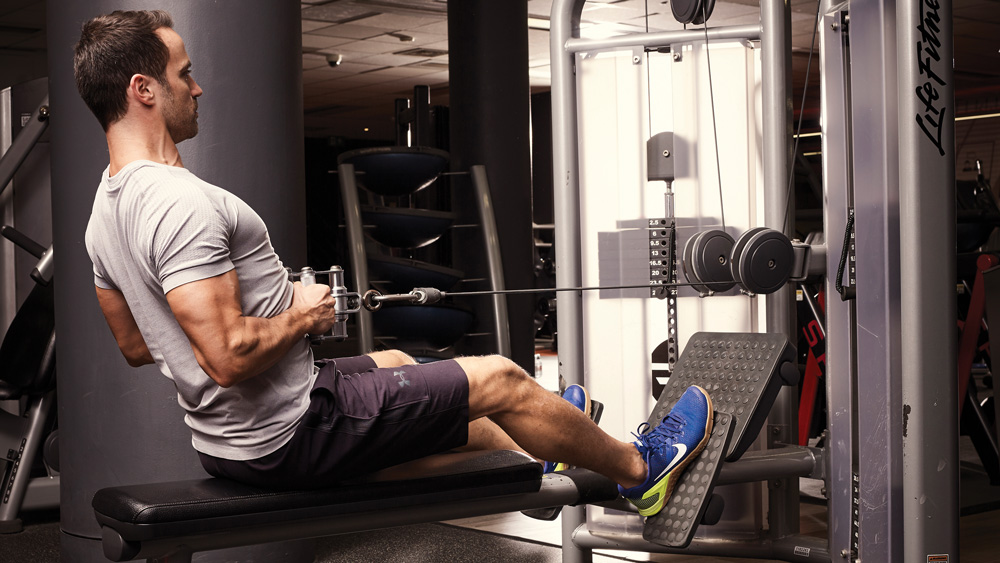
Two weeks is not a lot of time to lose a lot of weight, but if you’re committed you can start to make big changes to your body composition and, if you stick with it, the changes can be immense. Just ask the co-creator of The New Body Plan, Jon Lipsey, who took his own advice and used the training and nutrition plan to lose 10kg of fat in eight weeks.
Below, you’ll find a two-week “block” of workouts from the New Body Plan Plus’s fat loss plan. Pair it with this fat-loss meal plan and recipe guide to help you shift your belly without giving up the foods you love. But before you get started, here’s Lipsey’s motivation to do and experience of the plan.
What made you start the New Body Plan?
It was very simple. I was overweight and unhappy with how I looked and felt. My energy levels were low and my stress levels were high. That didn’t happen overnight. An increasing workload and a busy family life made me feel like I didn’t have time to train. I also saw a topless picture of myself on holiday that and I was like “is that what I look like?” Until then I’d been kidding myself that I was in all right shape.
Had you ever done anything like it before?
Never. I had never trained with the intention of improving my body composition and I’d never had anything resembling a six-pack. In my 20s I’d done a few races, and then I got into strength training, but before I started the New Body Plan I hadn’t trained seriously for about five years.
Why hadn’t you done anything like this before?
If I’m brutally honest, fear. Fear of failure. I always doubted my ability to stick to a plan. And then I doubted that, if I did stick to it, I’d see any meaningful results so I nearly talked myself out of doing it before I even started. I realise now that it was just my mind that was holding me back.
Why did it work?
First, because it’s based on some really sound training and nutritional principles – concepts that are proven to get results. The other big thing is that it’s a plan that has been designed to be used in the real world. So it’s realistic about the time you have to spend training and it involves a sustainable way of eating, rather than one that makes you feel hungry and miserable. It has also been designed to be progressive, so as you get fitter, it gets more challenging. The idea is that you should look forward to, rather than dread, your next training session.
What’s your advice for anyone who wants to change the way they look and feel?
The first thing I’d say is that you can achieve more than you think is possible, if you use the right plan. Whether that’s the New Body Plan or another programme, it’s vital that you set yourself up for success. You need to ask yourself why you’re doing the plan and how much you want the result. Once you have an answer to those questions, commit to the process and take it one session at a time. Focus on executing each rep to the best of your ability and you’ll get the result you’re looking for.
Get the Coach Newsletter
Sign up for workout ideas, training advice, reviews of the latest gear and more.
Your transformation ended in May 2018. Have you kept it up?
I have. The experience changed my life. And because it is a sustainable system, I’ve managed to still exercise and eat well despite having a new baby and a heavier workload than ever. I’m 40 next year and my aim is to enter that decade in better shape than I was when I was 20.
How To Follow This Fat Loss Plan
Here’s the theory behind why the workouts are so effective, and how you can tailor the plan to your body shape goals.
Split In this two-week training block the workouts follow a pattern. The first session of both weeks is an upper-body workout, which hits your chest, back, shoulders and arms. The second is a lower-body session, which targets your legs. The third session works your upper body again, while the fourth and final workout targets the muscle group you most want to make bigger and more defined – your abs, arms or chest. Aim to train on Monday, Wednesday, Friday and then Saturday or Sunday.
Structure Every workout in this two-week block is made up of six different exercises, which you’ll perform as straight sets. This means you do all the sets and reps of exercise 1, sticking to the tempo and rest periods detailed, and then move on to do all the sets and reps of exercise 2, and so on until you finish all the reps of the final set of exercise 6. This approach will fully test your muscles to improve your strength levels, while also burning enough calories to start stripping away fat.
Progression The second week of this block is similar to the first week in that it follows the same muscle-group split – upper body, lower body, upper body, then a body-part specific session, for your four weekly sessions. The moves are also the same and in the same order, but with one major difference: to help you lose fat faster you’ll do an extra two reps in every set of the first two moves of each session, and then do a full extra set for the other four moves. Try to lift slightly heavier weights for each move in the second week.
Tempo Alongside the sets, reps and rest period details for each exercise you’ll see a column marked “tempo”, which is a four-digit number. Tempo is the speed at which you perform one rep, and the number is the time in seconds you take to lower and lift the weight, and pause at the top and bottom. For example, a 2010 tempo for the bench press means you lower the bar to your chest in two seconds, with no pause at the bottom, then lift the bar in one second, with no pause at the top. X means you should do the move explosively.
Specialisation For the fourth session of both weeks you choose which muscle group you train. There are three options: abs, arms or chest. Pick just one. These muscle-group goal workouts use straight sets like the other three weekly sessions, so do the exercises in order as instructed to add serious size to your chosen muscle fast. In the second week, as with the other three sessions, do two extra reps per set of the first two moves, then a full extra set of the next four moves to train both harder and smarter.
See related :
- Fat-Loss Workouts: Five Circuits To Build Muscle
- The Weight-Loss Workouts Which Helped This Man Shed 2.5kg Of Fat In Two Weeks
- The Four-Week Lean Muscle Workout Plan
Workout 1: Upper Body
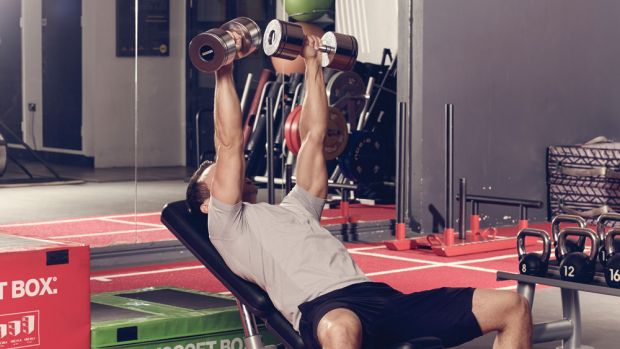
To make the most of this session, concentrate on some key form tips. Don’t let the dumbbells clash at the top of the bench press and avoid leaning back to use momentum on the lat pull-down. For the biceps curl and the triceps press-down, try to minimise the movement of your upper arm. That will focus your effort on the target muscle.
| Exercise | Sets | Reps | Tempo | Rest |
| 1 Incline dumbbell bench press | 4 | 10 | 2010 | 60sec |
| 2 Wide lat pull-down | 4 | 10 | 2011 | 60sec |
| 3 Machine overhead press | 3 | 12 | 2010 | 60sec |
| 4 Cable cross-over | 3 | 12 | 2011 | 60sec |
| 5 Cable bar biceps curl | 3 | 12 | 2011 | 60sec |
| 6 Cable bar triceps press-down | 3 | 12 | 2011 | 60sec |
Workout 2: Lower Body
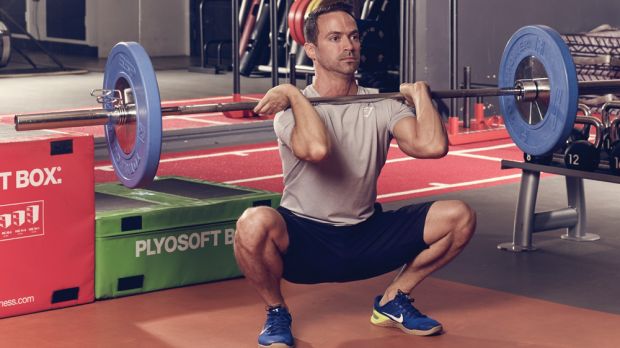
Front squats are technically challenging, so if you can’t get your arms into the position pictured, do them with the bar resting on the front of your shoulders and your arms out in front of you. In the Romanian deadlift keep your weight on your heels and push your bum back, keeping the bar close to your legs, to make the move effective.
| Exercise | Sets | Reps | Tempo | Rest |
| 1 Front squat | 4 | 10 | 2010 | 60sec |
| 2 Romanian deadlift | 4 | 10 | 2011 | 60sec |
| 3 Leg extension | 3 | 12 | 2011 | 60sec |
| 4 Hamstring curl | 3 | 12 | 2011 | 60sec |
| 5 Weighted crunch reach | 3 | 12 | 1111 | 60sec |
| 6 Weighted seated Russian twist | 3 | 12 | 1111 | 60sec |
Workout 3: Upper Body
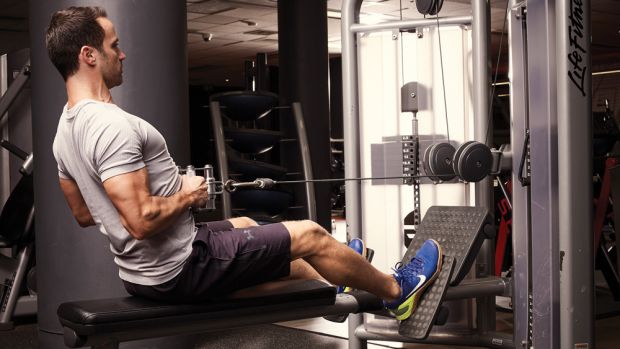
When you do the bench press, make sure that you use a full range of motion, even if that means reducing the weight. You’ll get a better result when you perform the move properly. On the seated row, pictured above, aim to minimise torso movement. That will focus the effort on the back muscles. Keeping your elbows in tight to your sides will also help.
| Exercise | Sets | Reps | Tempo | Rest |
| 1 Bench press | 4 | 10 | 2010 | 60sec |
| 2 Seated row | 4 | 10 | 2011 | 60sec |
| 3 Dumbbell overhead press | 3 | 12 | 2010 | 60sec |
| 4 Cable straight-arm pull-down | 3 | 12 | 2011 | 60sec |
| 5 EZ-bar biceps curl | 3 | 12 | 2011 | 60sec |
| 6 EZ-bar lying triceps extension | 3 | 12 | 2010 | 60sec |
Workout 4: Specialisation Session
How to pick your specialisation: Do one of the following sessions as your fourth workout of the week. Simply choose the body part you most want to develop. In the second week, as with the other three sessions, do two extra reps per set of the first two moves, then a full extra set of the next four moves to train both harder and smarter
Option 1: Abs

| Exercise | Sets | Reps | Tempo | Rest |
| 1 Kettlebell swing | 4 | 10 | X | 60sec |
| 2 Kettlebell halo | 4 | 10 | X | 60sec |
| 3 Hanging knee raise | 3 | 12 | 1111 | 60sec |
| 4 Hanging knee raise twist | 3 | 12 | 1111 | 60sec |
| 5 Plank shoulder tap | 3 | 12 | 1111 | 60sec |
| 6 Plank toe tap | 3 | 12 | 1111 | 60sec |
Option 2: Arms
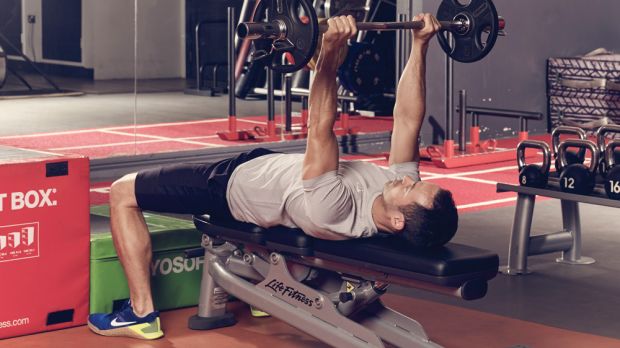
| Exercise | Sets | Reps | Tempo | Rest |
| 1 EZ-bar biceps curl | 4 | 10 | 2011 | 60sec |
| 2 Dumbbell hammer curl | 4 | 10 | 2011 | 60sec |
| 3 EZ-bar lying triceps extension | 3 | 12 | 2010 | 60sec |
| 4 EZ-bar lying triceps press | 3 | 12 | 2010 | 60sec |
| 5 Cable bar biceps curl | 3 | 12 | 2011 | 60sec |
| 6 Cable bar triceps press-down | 3 | 12 | 2011 | 60sec |
Option 3: Chest

| Exercise | Sets | Reps | Tempo | Rest |
| 1 Machine chest press | 4 | 10 | 2010 | 60sec |
| 2 Decline dumbbell bench press | 4 | 10 | 2010 | 60sec |
| 3 Incline dumbbell hammer press | 3 | 12 | 2010 | 60sec |
| 4 Incline dumbbell flye | 3 | 12 | 2010 | 60sec |
| 5 Cable cross-over | 3 | 12 | 2011 | 60sec |
| 6 Press-up | 3 | 12 | 2010 | 60sec |
Fast Track Your Fat Loss
Use these tips to maximise return on your gym time.
Treat every session like it’s your last Imagine that every session you do is the last workout of the plan and that at the end of it, you’re going to have to step in front of a camera with your top off. If that’s what’s at stake, you’re less likely to coast.
Rest for succes It’s tempting to be generous with your rest periods – resting for 90 seconds, say, as opposed to the 60 seconds described in the plan. Resting for longer may allow you to lift a slightly heavier weight, which is good for the ego. But what’s good for the ego is rarely good for the waistline. Sticking to the rest periods will increase the energy demand (and therefore the calorie burn and fat loss effect) of the workout and help you to fatigue your muscle fibres effectively.
Remind yourself why Training intensely is tough, so when the workouts get challenging take a minute to remind yourself why you started. Also think about what you want to achieve by the end of the plan, and ask yourself honestly whether you think 50% or 100% effort is more likely to help you hit your goals.
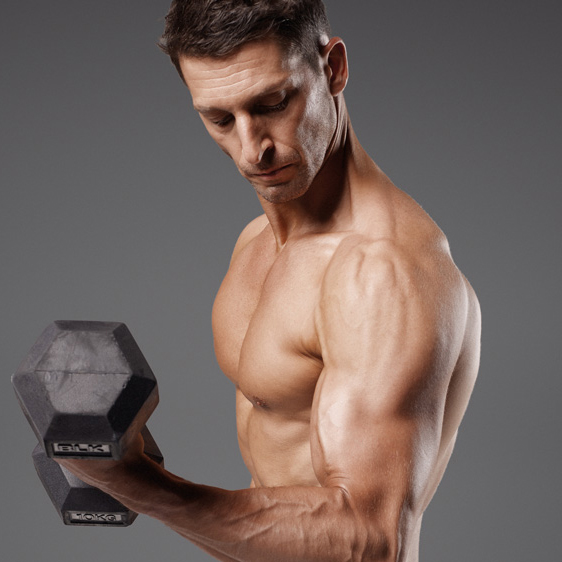
Joe Warner is a highly experienced journalist and editor who began working in fitness media in 2008. He has featured on the cover of Men’s Fitness UK twice and has co-authored Amazon best-sellers including 12-Week Body Plan. He was the editor of Men’s Fitness UK magazine between 2016 and 2019, when that title shared a website with Coach.









